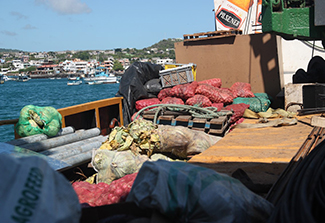When overweight and undernourished live under one roof
July/August 2024 | Volume 23 Number 4
 Photo courtesy of Amanda Thompson
People living in remote communities, like the Galapagos, often rely on food that is shipped in.
Photo courtesy of Amanda Thompson
People living in remote communities, like the Galapagos, often rely on food that is shipped in.
Childhood obesity is at an all-time high in the U.S., a trend mirrored across Latin America. Researchers working on interventions to reverse this trend shared recent results and lessons learned at the
Childhood Obesity Prevention Across Borders project, coordinated by Fogarty's Center for Global Health Studies. The assembled participants believe that research on overweight and malnutrition in Latin America might inform public health in the U.S.
A presentation by Amanda Thompson, professor at University of North Carolina (UNC), Chapel Hill, focused on a pattern seen in roughly 85% of Ecuadorian homes, where a dual burden of being overweight (or obese) and micronutrient deficiencies exists. Examples would be overweight adults living alongside children suffering from undernutrition…or overweight individuals who are also anemic. Studies record a lot of zinc deficiencies as well as anemia in this group, said Thompson. “Ecuador also has high rates of stunting.” (Children are described as "stunted" when their height-for-age is more than two standard deviations below median WHO values.)
Thompson, an anthropologist who specializes in human biology, has worked in Galapagos since 2014. Her studies dovetail with the Peru-based research of Peggy Bentley, professor emeritus at UNC’s Gillings School of Global Public Health. They’ve collaborated in the past on a Fogarty project that aimed to develop interventions for reducing obesity, cardiometabolic disease and undernutrition in the Galapagos. Discussing recent studies, the two wanted to hear from others working in Ecuador, Peru, and the U.S. Supported by a Cross Borders conference grant, their plans for a live meeting were disrupted by COVID-19 and political unrest in the region, so they hosted a hybrid event with many researchers joining online.
Multiple causes
The dual burden of overweight and undernutrition, though most often seen in middle income countries, cuts across all nations, whether low-, middle-, or high- income. “There are similar causes and different causes across those contexts,” said Thompson. Lack of access to resources due to inequality is an important consideration. “In Latin America, we tend to see this dual burden focused in rural, lower-income, and indigenous populations. In the U.S., we would see it among racialized minority groups more than other groups,” she said.
Poor diet also contributes to this health problem, though an insufficient diet may not look the same in all places. Environmental factors are another concern. Minimal access to clean water can lead to diarrhea or recurrent infectious diseases in children, which may, in turn, cause undernutrition, explained Thompson. “In Galapagos, people who are concerned about their water quality are more likely to consume non-water beverages,” said Thompson. Similarly, in the U.S., those who perceive their water quality as poor are more likely to consume sugar-sweetened beverages.
Meanwhile, some low- and middle- income countries are experiencing a surge of socioeconomic growth. “In Galapagos, you have this rapid expansion of the tourism industry, so people have considerably more income than generations before them or families on the mainland,” said Thompson. Greater purchasing power often translates to buying unhealthy processed food. Sometimes rapid urbanization occurs without the necessary infrastructure, noted Thompson. “More people are living in a densely urban environment without improvements in sanitation systems or access to clean water.” Social factors also play a role. “We see women migrating or marrying into families that have been living on the island.” These new Galapagos moms can feel isolated; it's a safer environment, but the water quality is sometimes poor, and they can't always feed their children the foods they want. Water or food insecurity is a strong predictor of maternal distress, noted Thompson, adding that a mother’s mental state often predicts her child’s health.
Fresh outcomes
How this dual burden affects childhood development remains “an open question. What is still sort of hotly debated in the literature is whether undernutrition (and particularly stunting) and micronutrient deficiencies in early life are associated with long-term risk of overweight and obesity,” said Thompson.
A welcome consequence of the conference has been a general desire for more collaborations. Thompson said, “The group in Peru has been doing long-term interventions and we've done a lot of interventions in the U.S. So how can we take what we've learned to think about an intervention that either focuses solely on Ecuador or on both Peru and Ecuador?” A search for appropriate grant mechanisms led the researchers to consider Fogarty training programs. “We’re strongly interested in building capacity.” Meanwhile, Thompson’s group has begun a small pilot study around childhood feeding and household diets. “This formative work with families will help us see the barriers they face, and we’ll work with them to co-create some potential solutions.”
More Information
Updated August 13, 2024
To view Adobe PDF files,
download current, free accessible plug-ins from Adobe's website.
Related World Regions / Countries
Related Global Health Research Topics